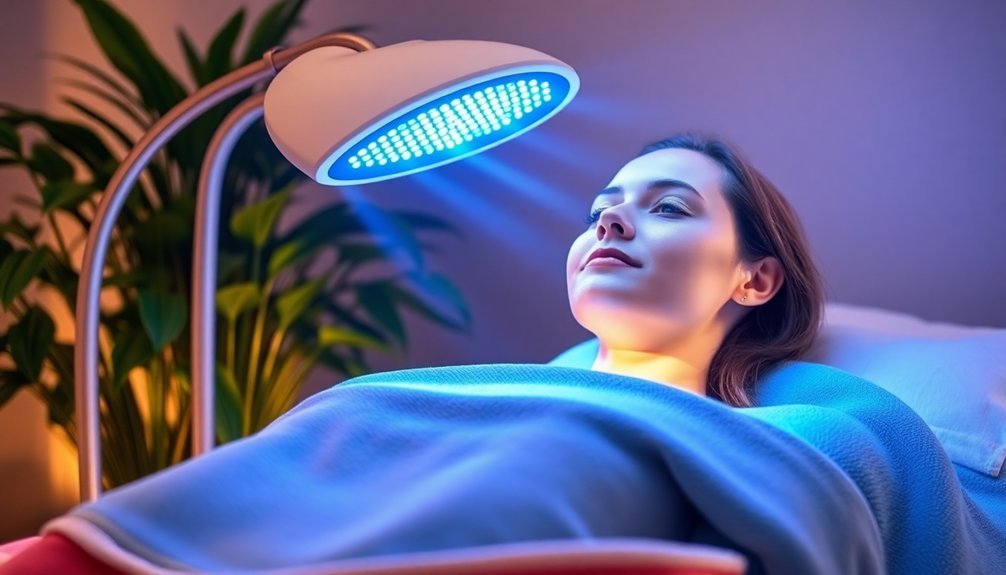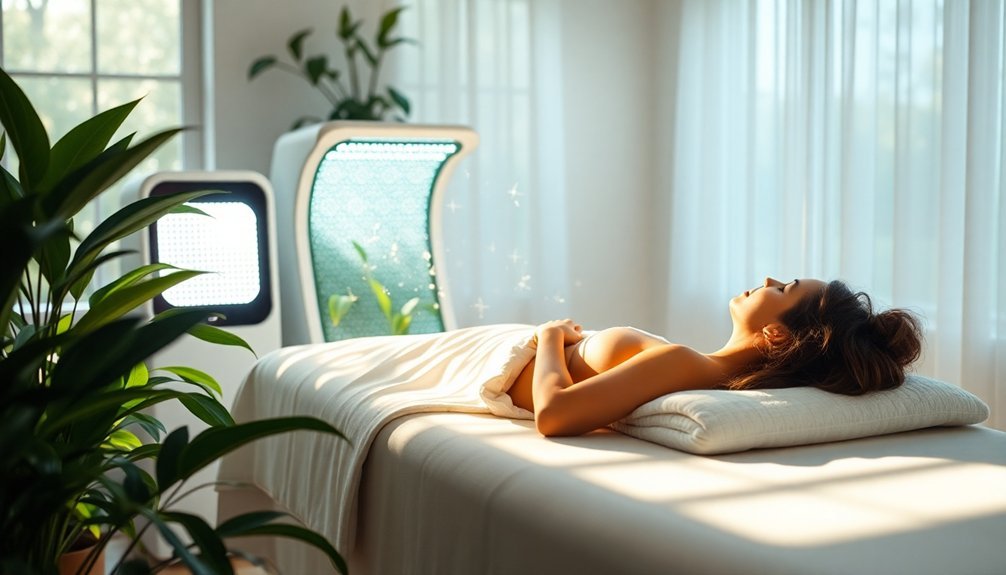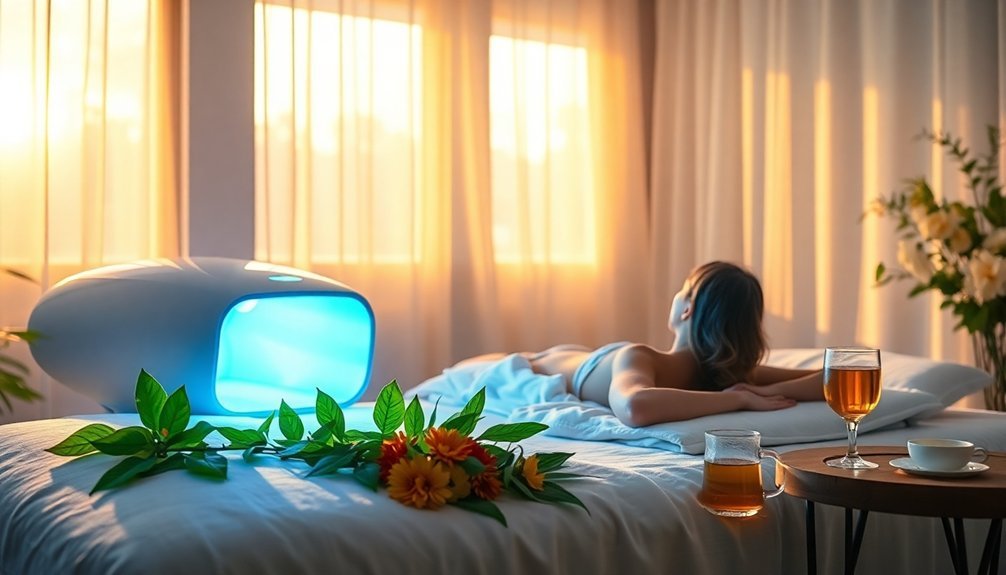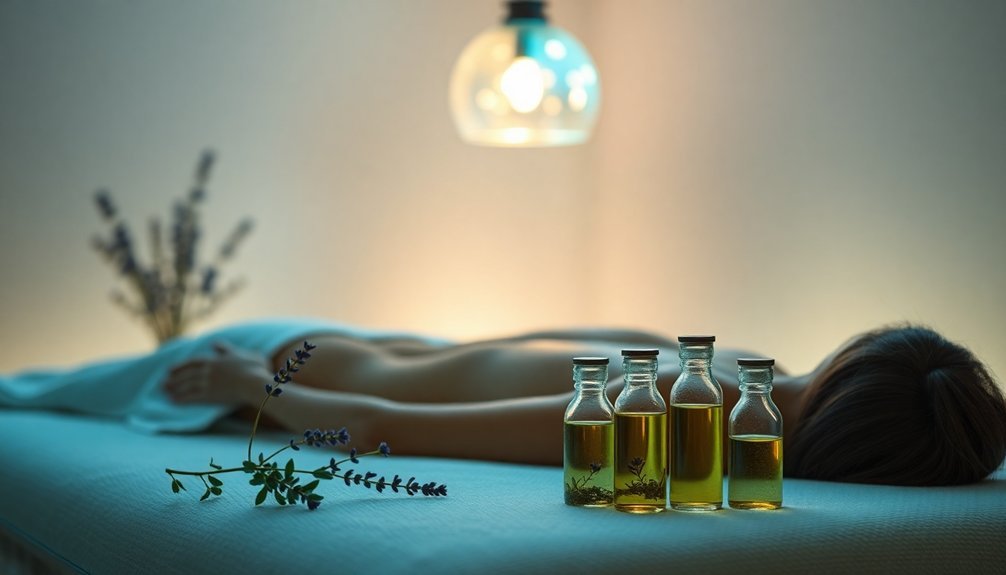Phototherapy can notably optimize your lymphatic flow in several ways. First, it reduces swelling and puffiness by stimulating lymph vessel contraction. Second, it boosts circulation by enhancing blood and lymphatic fluid flow, helping clear waste. Third, it supports immune health, which is essential for effective lymphatic function. Fourth, it aids post-surgery recovery by minimizing swelling and promoting natural healing. Finally, it eases chronic conditions by improving fluid movement and reducing inflammation. Each of these benefits can transform your wellness routine, and there's more to discover about how these therapies work wonders for your health.
Reducing Swelling and Puffiness

Red light therapy works wonders in reducing swelling and puffiness, making it a go-to treatment for many experiencing fluid retention. By penetrating the skin, red light stimulates the contraction of lymph vessels, increasing the lymphatic flow rate. As adenosine triphosphate (ATP) production inside your cells rises, cellular function and repair improve, helping to reduce inflammation and swelling effectively. Research indicates that RLT's impact on lymphatic drainage can be particularly beneficial for those seeking relief from chronic conditions.
This therapy is especially beneficial in areas like your legs, arms, and face, where excess fluid often builds up due to poor lymphatic drainage. If you're dealing with lymphedema, injury, or post-surgery swelling, red light therapy can ease discomfort and promote faster recovery.
You'll also notice a difference in puffiness around your face and neck, particularly near the lymph nodes under your jawline. Beyond cosmetic benefits, it's widely used in clinical applications, especially after breast cancer surgery. With its ability to support the growth of new lymphatic vessels and enhance overall lymphatic function, red light therapy can be an essential part of your wellness routine.
Boosting Circulation
Boosting circulation is essential for overall health, and phototherapy makes it a practical solution. Red light therapy effectively enhances blood and lymphatic fluid flow by penetrating your skin and stimulating cellular function. By increasing the production of adenosine triphosphate (ATP) inside cells, it energizes the cells involved in fluid movement, leading to better circulation.
As vasodilation occurs, lymphatic vessels relax, improving lymph flow. This relaxation is partly due to increased nitric oxide production, which acts on smooth muscle cells, further enhancing lymphatic vessel function. The therapy stimulates the contraction of lymph vessels, increasing the lymphatic flow rate while allowing larger molecules to pass more easily, aiding in waste clearance. Research has shown that red light therapy can effectively reduce symptoms related to lymphedema for those suffering from this condition.
You'll notice that improved lymphatic circulation helps reduce feelings of heaviness or tightness, accelerates healing post-surgery, and speeds up recovery after exercise. It's particularly beneficial for managing chronic conditions like lymphedema and assists in detoxing areas prone to fluid retention.
For ideal results, apply red light therapy to specific areas like the legs, abdomen, and arms consistently. When combined with healthy habits like hydration, you'll amplify its benefits even more.
Supporting Immune Health

Enhanced lymphatic flow not only improves circulation but also plays a crucial role in supporting immune health.
Phototherapy effectively modulates inflammatory responses, balancing acute and chronic inflammation to help your immune system function better. Techniques like NB-UVB light therapy reduce pathological inflammation and boost the intracellular killing of pathogens, leading to a more robust immune response.
Moreover, phototherapy stimulates the production of mitochondria within immune cells, increasing their energy reserves. This enhancement allows immune cells, like macrophages and neutrophils, to recognize and eliminate pathogens more efficiently. The potential for improved immune function is crucial as global AD cases continue to rise, emphasizing the need for effective therapies.
By triggering molecular responses in your skin, UV radiation can activate these immune responses even further.
Light therapy also helps remove dysfunctional cells through apoptosis, while promoting the activity of regulatory T cells that aid recovery in inflammatory conditions like psoriasis.
As a result, your lymphatic system benefits from improved immune function and reduced inflammation, which fosters healthier lymphatic drainage.
In essence, by reducing inflammation and enhancing immune cell function, phototherapy can greatly support your overall immune health, paving the way for better recovery and resilience against various health challenges.
Enhancing Post-Surgery Recovery
After surgery, your body faces the challenge of healing and recovering, and effective management of lymphatic flow can greatly support this process. Lymphatic therapy techniques, like Venus Radiofrequency Therapy and Manual Lymphatic Drainage (MLD) massage, work wonders in reducing post-operative swelling and bruising. By stimulating the lymphatic system, these therapies help clear excess fluids and waste products, promoting faster healing and improving circulation.
Additionally, MLD not only alleviates discomfort but also accelerates the healing of soft tissue injuries. Devices like LymphaTouch enhance these benefits, using negative pressure to further reduce swelling and manage scar tissue effectively. This leads to improved flexibility and mobility while minimizing tightness in the affected areas.
Moreover, utilizing lymphatic drainage methods promotes the movement of excess fluids and waste products from the surgical site, optimizing your body's natural healing abilities. By enhancing circulation and waste removal, lymphatic therapy accelerates your recovery time, alleviating pain and discomfort along the way.
Ultimately, incorporating these therapies into your post-operative care can create a smoother recovery experience with better overall outcomes.
Easing Chronic Conditions

While chronic conditions can considerably impact your quality of life, phototherapy offers effective ways to alleviate symptoms and improve your overall well-being.
For instance, red light therapy is particularly good at reducing swelling and puffiness by enhancing fluid movement. This is especially helpful if you struggle with swollen legs, arms, or your face after long periods of sitting or standing.
Moreover, phototherapy boosts circulation, allowing better blood and lymphatic flow. With enhanced circulation, your body can effectively remove waste and toxins, making you feel lighter and more agile. It's like giving your lymphatic system a much-needed workout!
It also plays a significant role in supporting immune health. By maintaining proper lymphatic drainage, your body can flush out harmful substances, keeping infections at bay.
Additionally, if you suffer from pain and inflammation related to chronic conditions, phototherapy can provide relief. It improves fluid movement and reduces toxin buildup, easing symptoms of stiffness and swelling.
With its non-invasive approach, you can conveniently integrate this therapy into your at-home health routine. Consider incorporating phototherapy into your life for a proactive step toward managing chronic conditions.
Frequently Asked Questions
How Long Does a Typical Red Light Therapy Session Last?
A typical red light therapy session lasts 10 to 20 minutes, depending on the treatment area and your needs. For sensitive skin, you might want to start with shorter sessions and gradually increase the duration.
Are There Any Side Effects From Using Red Light Therapy?
Yes, red light therapy can cause side effects like headaches, skin irritation, eye strain, and interactions with certain medications. It's important to consult a doctor if you have concerns or pre-existing conditions before starting treatment.
Can Red Light Therapy Be Used Alongside Other Treatments?
Yes, you can definitely use red light therapy alongside other treatments. It enhances skin health, promotes muscle repair, and supports neurological conditions, making it a versatile option for improving overall health and recovery.
How Often Should I Undergo Red Light Therapy for Optimal Results?
You should undergo red light therapy 3-5 times a week for ideal results. Make sure to allow 1-2 days between sessions, keeping each session to 10-20 minutes for the best outcomes.
Is Red Light Therapy Safe for All Skin Types?
Yes, red light therapy's considered safe for all skin types. It's non-invasive, gentle, and doesn't use UV radiation. You can benefit from its healing properties, even if you have sensitive or darker skin.
In Summary
Incorporating phototherapy into your wellness routine can be a game-changer for your lymphatic flow. By reducing swelling, boosting circulation, and supporting immune health, you're giving your body the tools it needs to thrive. Plus, if you're recovering from surgery or managing a chronic condition, phototherapy can offer significant relief. Embrace this innovative approach and experience the benefits firsthand—your lymphatic system will thank you!





Leave a Reply